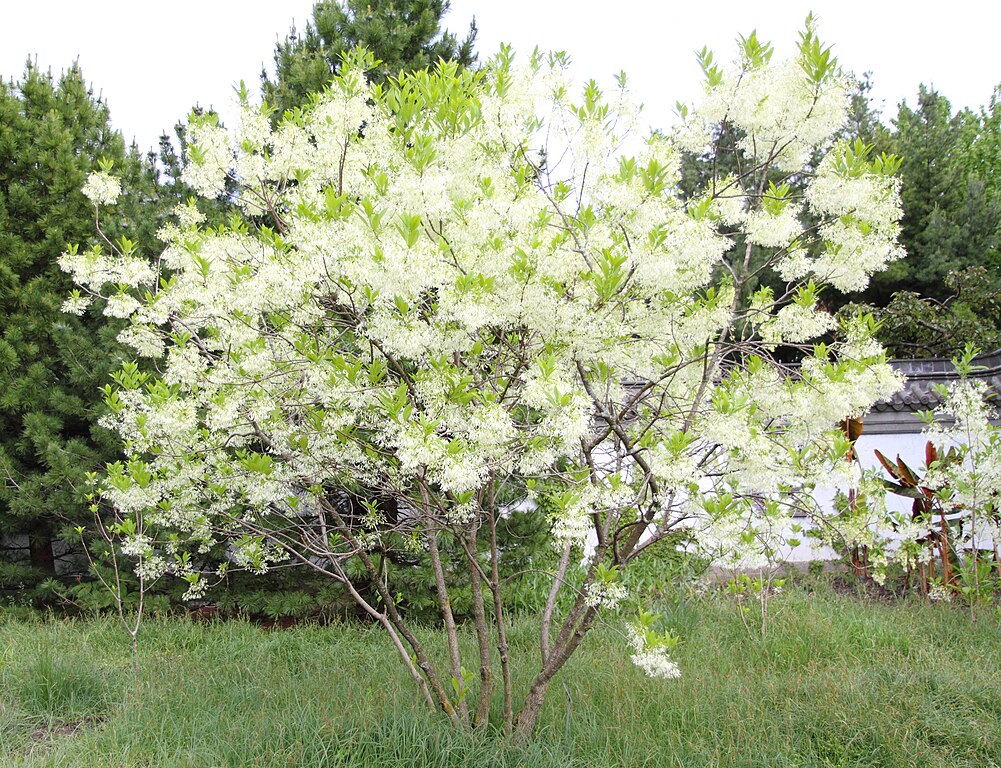Chapter 87 Chionanthus virginicus
87.2 Soil: Moist Deciduous Mix
Ratio: 4 parts bark, 1 part grit
Add-ins: dolomitic limestone (~5 lbs/yd), Tree-Tone (15 lbs/yd)
pH: ~6.5 (slightly below neutral)
Moisture: medium moisture. Does not tolerate prolonged dry conditions.
87.3 Light
Routine: likes full sun to part shade.
Summer: afternoon shade.
87.4 Cultivation Notes

Closer view of the flowers on a fringe tree. Link to original image.
87.4.1 Potting & Root Pruning
Schedule: unknown.
Notes: they do not transplant well, so I suggest being very conservative with root pruning.
87.4.1.1 Top & Branch Management

Underside view of a fringe tree showing the branching structure. Link to original image.
Heavy pruning: prune immediately after it flowers so the branches have time to develop next year’s flower buds.
Fringe trees only put out one flush of growth each year. So do not expect to see extensive growth once the first spring push ends.
Fine pruning: the shrub-like form can be shaped into a small tree form by pruning the lower limbs and foliage away.
Leaf pruning: not appropriate.
87.4.2 Feeding
Fringetree likes more fertile and slightly acidic soil, but not as acid as camellias or azaleas. Alternate between 18-6-12 (Miracle-Grow liquid) and Miracid (30-10-10), both at half strength. Alternatively use a 1:1 mix of Tree-Tone and Holly-Tone.
87.4.3 Pests & Problems
No serious pests or problems. Can develop scale when drought-stressed. Can be an alternative host for emerald ash borers.
87.4.4 Winter Storage
Dark blue fruits appear in late summer, but are eaten quickly by birds. Link to original image.
Store in mulch outdoors. Try to place in a shaded area so buds do not break in a mid-winter warm spell.
87.5 Propagation Notes
I was unable to grow them successfully from seed, but have only tried once; seed is not easy to locate commercially, and I have not found a seed-bearing tree from which to collect.
87.6 Artistic & Styling Notes
It has large leaves so will look better in a naturalistic rather than formal style. Tends to form multi-stem groups.
87.7 Additional Information
87.7.1 Natural History
Native to the central and eastern US, from Texas to New York. Hardy in USDA Zones 3 to 9. Creamy white hanging threadlike flowers (hence the name) appear from May to June. They bloom young; I have two in my collection that are less than 5 years old, and both have bloomed already.
They are small understory trees, similar in growth habits (but not soil conditions) to dogwoods. A tree that is 20 feet tall and wide is near the maximum size for this species.
The trees are dioecious (separate male and female plants), but also may have perfect flowers in some clusters. Male flowers are showier than female flowers. Fertilized female flowers form small bluish black round fruits in late summer. Leaves turn yellow in fall.
87.7.2 In Cultivation
Occasionally available in nurseries, usually the unselected species. A few cultivars are also available, including:
- ‘Emerald Knight,’ a male cultivar that does not produce fruit.
- ‘Prodigy,’ a smaller selection with more blooms.
- ‘Spring Fleecing,’ another small male selection that has narrower, darker leaves and flowers heavily.
- A dwarf form is available that some classify as a separate species.
- The Chinese fringetree (Chionanthus retusus) is a denser growing but less hardy cousin that was brought here from Asia.

